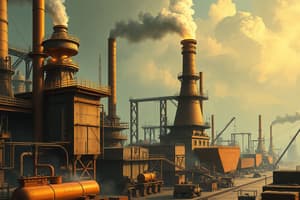Podcast
Questions and Answers
What was a significant impact of the Bessemer Process on the quality and quantity of steel production?
What was a significant impact of the Bessemer Process on the quality and quantity of steel production?
- It focused solely on improving production techniques.
- It increased both the amount and the quality of steel produced. (correct)
- It eliminated the need for iron entirely.
- It reduced the production time significantly.
Which of the following applications benefited from the advancements made possible by the Bessemer Process?
Which of the following applications benefited from the advancements made possible by the Bessemer Process?
- Construction of world’s first skyscrapers (correct)
- Development of wood-based machinery
- Automobile manufacturing
- Production of glass
What was one of the economic benefits associated with the Bessemer Process?
What was one of the economic benefits associated with the Bessemer Process?
- It increased production costs while enhancing quality.
- It led to more expensive raw material sources.
- It reduced the need for workers in steel production.
- It made production techniques more economical. (correct)
How did the Bessemer Process influence railroad infrastructure?
How did the Bessemer Process influence railroad infrastructure?
Which statement best describes the relationship between the Bessemer Process and technological innovations in steel production?
Which statement best describes the relationship between the Bessemer Process and technological innovations in steel production?
What was a significant factor behind America's economic growth during the industrialization period?
What was a significant factor behind America's economic growth during the industrialization period?
What process increased the quantity and quality of steel production?
What process increased the quantity and quality of steel production?
Which groups started working on the Transcontinental Railroad from different directions?
Which groups started working on the Transcontinental Railroad from different directions?
The Transcontinental Railroad reduced travel and shipping time from several months to a few weeks.
The Transcontinental Railroad reduced travel and shipping time from several months to a few weeks.
What was one major impact of the development of a national market due to railroads?
What was one major impact of the development of a national market due to railroads?
The period between 1850 - 1900 saw the US population grow 3x due to ______ and immigration.
The period between 1850 - 1900 saw the US population grow 3x due to ______ and immigration.
What term describes a business strategy that involves merging companies producing similar products?
What term describes a business strategy that involves merging companies producing similar products?
What act prohibited unfair practices by railroads?
What act prohibited unfair practices by railroads?
The Sherman Anti-Trust Act of 1890 allowed monopolies to engage in unfair business practices.
The Sherman Anti-Trust Act of 1890 allowed monopolies to engage in unfair business practices.
Match the following terms with their definitions:
Match the following terms with their definitions:
Who was known as a 'Robber Baron' in the Gilded Age?
Who was known as a 'Robber Baron' in the Gilded Age?
Flashcards are hidden until you start studying
Study Notes
The Bessemer Process and its Impact
- The Bessemer process revolutionized steel production, significantly increasing both the quantity and quality of steel manufactured.
- Widespread adoption of iron, and then steel, in construction replaced wood as the primary building material.
- Advancements in production techniques made steel manufacturing more economical.
- The improved steel facilitated the expansion of railroad networks, construction of early skyscrapers, and manufacturing of superior machinery.
America Industrializes Post-Civil War
- Rapid industrial growth following the Civil War.
Entrepreneurship's Influence
- Entrepreneurs significantly impacted the American economy.
Labor Conditions
- Industrial growth involved worker exploitation.
Bessemer Process
- Replaced iron with steel.
- Improved steel production techniques and lowered costs.
Technological Innovations
- The Bessemer process increased steel quantity and quality.
- Steel enabled expanded railroads, skyscrapers, and improved machinery.
Transcontinental Railroad
- Construction involved Civil War veterans, Irish laborers, Chinese workers, and freed African Americans.
- Started from Omaha (westward) and Sacramento (eastward).
- Met at Promontory Point, Utah.
- Significantly impacted the West's economic, cultural, and social development.
Railroad Growth
- Transcontinental railroad connected at Promontory Point, Utah.
- Reduced travel and shipping times from months to weeks.
- Created a national market benefiting consumers and producers.
National Market Development
- Railroads, canals, telegraphs, and telephones interconnected the nation.
- Reduced shipping costs for raw materials and finished goods.
- New sales methods emerged: department stores, chain stores, and mail-order houses (e.g., Sears).
Population Impact
- Significant 19th-century population growth (tripled between 1850-1900).
- Growth fueled by birthrates and immigration.
- Created high demand for goods and a large, inexpensive labor pool.
Modern Economy Emergence
- Cause: Railroad expansion (Transcontinental Railroad), population growth, technological advancements.
- Effect: Improved trade routes, reduced travel time, industrial labor force, increased market demand, improved living standards.
Big Business Characteristics
- Efficiency leading to lower prices.
- Large workforces.
- Potential worker exploitation.
- Mass production.
- Potential environmental disregard.
- Resources for research and innovation.
- Potential unfair government influence.
Free Enterprise System
- Corporations owned by individuals or groups.
- Open market for buying and selling.
- Businesses aim for profit through goods and services production.
- Government protection of business through laws (e.g., tariffs).
Entrepreneurs
- Individuals starting businesses for profit.
- "Gilded Age" entrepreneurs labeled "Captains of Industry" and "Robber Barons."
- Examples: Andrew Carnegie (Carnegie Steel, philanthropist), John D. Rockefeller (Standard Oil, monopoly).
Vertical and Horizontal Integration
- Horizontal Integration: Merging companies producing similar products (Rockefeller's approach). Example: Walt Disney acquiring 21st Century Fox.
- Vertical Integration: Controlling raw materials and transportation (Carnegie's approach). Example: MGM and Paramount Pictures owning movie theaters.
Taming Industrial Juggernauts
- Laissez-faire economics: minimal government regulation.
- Initial government hesitation to regulate businesses.
Laws Against Anti-Competitive Practices
- Laissez-faire: minimal government interference.
- Interstate Commerce Act (1887): prohibited unfair railroad practices.
- Sherman Antitrust Act (1890): prevented monopolies from engaging in unfair business practices.
Trusts and Holding Companies
- Trust: Legal arrangement for managing another's property; trustee manages assets.
- Purpose: Reduce competition, control industries, set prices and wages.
- Holding Company: Owns stocks or businesses in various industries. Example: An oil refinery owning other related businesses.
Studying That Suits You
Use AI to generate personalized quizzes and flashcards to suit your learning preferences.




